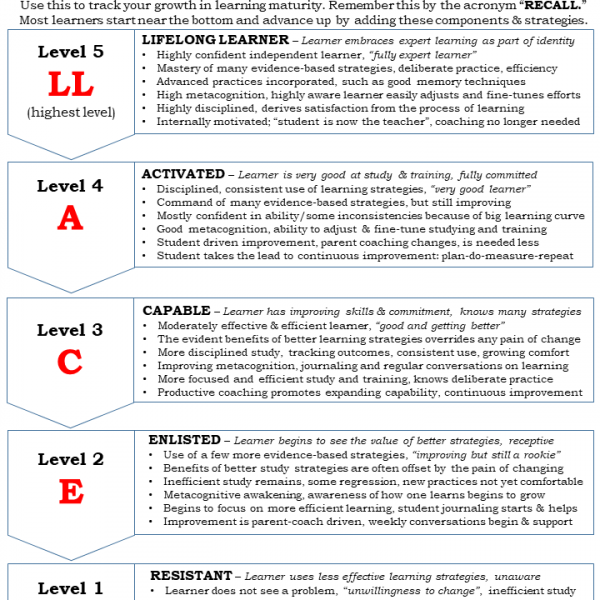
A Great Checklist on How to Learn Hard Things

Reading time: 12 minutes
The ability to learn hard things should be your goal. Anyone can learn the easy things. Lifelong learners don’t pull back from the hard stuff. How can you do this? Read more to find out.
Approach becoming a Superlearner as if you are training yourself for life’s journey. Because – you are! It’s a marathon, and your brain needs to be in shape. And you need the right tools.
Read this list of seven vital components that will get you there — use this as a worksheet to assess what you can be doing well, and what you will need to do to get better in the journey to expert learning.
1. Embrace a Learning Mindset
Start with changing how you think about learning with the idea that it’s all about growing your own brain. To do this you need to start with the right mindsets about learning. You are much more powerful than you think. Challenge your assumptions about your limitations.
Adapt Dr. Carol Dweck’s “Growth Mindset” and Angela Duckworth’s “Grit” to do a better job of tackling hard subjects. You start with cultivating the ongoing belief in your ability to grow yourself through your efforts and practice. We cover these in the Pa 10 course.
Remember that learning to master one hard thing improves your capability to master other hard things. The subjects you study and learn today become the framework for building future knowledge and skills. Learning one thing prepares you to learn many new things.
If you don’t understand this, learn about it. Start by going taking the Pa 10 course and review the exercise about your “amazing brain.” Check out other resources on this website.
2. Learn and Use Evidence-based Study Strategies
If you want to get far, you will need to learn how to master better learning strategies – these will enable you to learn the hard stuff. Evidence-based strategies provide the necessary foundation that help you learn smarter and faster. Most of the strategies you are using now are probably wrong according to Cal Newport. Junk those inefficient strategies you are using now. They create the illusion of learning effectively – and they’ll hold you back.
Understand that “learning how to learn” is really a discipline and set of skills that are mastered only through practice. It’s like learning to play that sport you like well – you have to first commit, work at it, focus on the goal, and with practice over time you will amaze yourself in how good you have become.
Complete the Pa 10 course and start family discussions on how to get comfortable with using better strategies. Begin supportive parent coaching. How will you do this? First build a list then work it! Assess where you are. Complete our free learning strategies assessment. Look for our upcoming online courses on more learning strategies so you can get even better.
Identify where you are with learning maturity. Start acquiring and practicing using more strategies. Learn to be flexible in your use of strategies – different disciplines and subjects require different tools.
When you master the use of evidence-based learning strategies, you will then know when and how to use the right ones.
Maybe you’ve heard the saying – “big hat, no cattle?” For students it’s, “Few strategies, no mastery.”
Avoid informal or unscientific study approaches because they will always underperform for you. Ditch sitting down to study without a detailed plan, it will not get you there. If you want to become a true lifelong learner, you will need a bag full of strategies and methods. Don’t show up for work with that empty bag. Fill it up first!
Load yourself up with good strategies. They will help you learn faster!
3. Stay on Track – Set Up a System
To get much better at anything, you need to establish a system to help you monitor your work over both the short and longer term. It’s really true – no system – little progress.
Find a solid approach that works for you and commit to it. What are the elements of a good system? First, you need to monitor more closely what you do when you study – cultivate the habit of completing a daily study journal, then using it to fine tune your system.
Learn from “best practices” of successful disciplines like professional sports teams, project management, the Marines, and companies like Amazon and Google. They establish plans and track their progress rigorously. You need a better effort to guide your weekly study, so start a weekly SPR meeting – use Study Planning and Review meetings to push yourself to work smarter.
You will need a coach to keep you stay accountable – enlist a parent to help you. Without a coach pushing you in this regular meeting, you’ll find it difficult to make steady progress.
It’s not really a system if you don’t track what you do. It’s not a good system if you don’t plan. It’s not a system if you don’t get the support to continuously try to improve it. The better system usually wins. Set up yourself to win.
Pay the price for something special. Your becoming a Superlearner is worth all of this effort. You can be a winner at life when you are that person who knows how to learn better and faster than others. Start building your system now!
4. Focus on your Process, not the Goal
All worthwhile things take time to master. But most people stumble because they get overly focused on big goals. Goals are fine to have, but if you want to get really better there is something more important.
When you work on something hard to learn, if you focus only on the goal, you are going to get frustrated, or worse, you may quit. It’s hard to be motivated by something so far over the horizon. If you want to get really good at a sport, playing the piano, or playing chess for examples, you are going to have to put in the time. The goal is going to be illusive while you are grinding away honing your skills. Becoming a Superlearner takes time.
For another example, as a native English speaker, say you want to learn Mandarin Chinese. It will likely take you about 1400 hours to get to a proficiency level of C1 (Advanced or Proficient). As that learner, you can expect it can get pretty frustrating when every day you are practicing away. Two hours a day, five days a week – it will take two and a half years to get there! If you focus only on the goal you might get discouraged.
So, if the goal isn’t right there to motivate you, then what is? Focus on the process itself.
What does this mean? You keep your head down and focus on the execution of your study process each day, and each week. You focus on the elements of your process and don’t worry about the goal, because you know it will happen.
This allows you to concentrate on what you can control now, allowing you to feel better that you are doing things right, along with the right things – which makes for good progress.
Goals are fine for many things– but focusing on a really good process is much better for getting what you really want!
5. Get a Coach to Hold You Accountable
In every sport, at almost every level, the best players have coaches. The best musicians also have them. Same with ballerinas. And don’t forget that in many professions like acting and flying airplanes this is also true – even the best business executives have coaches. So why not for you?
I know, I’ve been a coach for many of the heads of major companies. It’s too hard to master a field on your own. Don’t try to get great by yourself.
There is a strong link between having a coach and expert performance! Simply put, it’s hard to become an expert – at almost anything – without one. Coaches push us harder and better than we can ourselves. They give us feedback. They encourage us when we get down.
So – get help from a coach to become an expert learner. There is potentially a good one in your family. You the parent. Reach out to be that parent coach – offer your help – don’t wait for your kid to come to you.
Recognize using a coach is a sign of commitment, not one of weakness. It’s a smart decision to get a coach. And this one is free. Sign up for one of our parent coaching courses to learn how to do this.
6. Chart and Visualize Your Progress
There will always times when we find it difficult to stay motivated. This is especially true for the harder things – the ones that can transform us. Motivation is variable – that’s just human nature. So, you need to begin by having ideas on how you will stay motivated. Only the naive start the journey thinking everything will go as planned.
Frankly, this thinking is where most otherwise good efforts fall down. People assume that willpower and good intentions will be enough to carry them through the rough patches. But this is not so. Willpower fades like a muscle when it is overused. Good intentions slip when motivation isn’t there to support them. You need something more durable.
It’s important to create a way to maintain a sense of progress to maintain your motivation, especially at the times when the going seems slow. Having ways to measure and compare progress and accomplishments thus becomes very important. This is one reason why journaling as a practice to record progress is so important. Start a daily journal of your study practices and outcomes. Note what works better for you and what does not. Then adapt.
Consider other tools to help you feel successful as you move forward. How about creating a visual display on a whiteboard of what you have been learning? For example, if you are learning a new language at the rate of 8 new words a day, plot this. It may seem slow, but that’s 40 words a week given a 5-day study week, and therefore over 200 per month! Imagine a white board that tracks six months of this kind of progress!
If you start using 2 new learning strategies for the first month, then add two more in the next, that’s progress. When you discover through better methods you can now learn twice as many things in the same amount of study time as before –plot this. Write it down – talk about it – celebrate your successes!
Consider using multiple tools to record and track your progress. Talk often about your progress and celebrate your successes. Chart it. Make yourself feel good.
7. Recognize You will Stumble
Don’t fall into the traditional “suckers trap” of believing that you can make flawless progress supported only by the “goodness” of your goals and intentions. Becoming a lifelong learner is a great goal, but we are, after all, human. We all screw up, get tired, become distracted by other things, and continually get sucked into those seemingly promising shortcuts.
Plan for success – but prepare yourself for the inevitable setbacks.
With harder efforts, there are always things that don’t seem to cooperate. You should begin with this resilient mindset – you know you will face setbacks and things will not go to plan – expect this. And be ready for them. This is part of the “Grit” in #1 above.
There will always be backsliding when you try to change something– your brain will want to return to those “good old comfortable” habits. Take control of your brain. When you hit these inevitable unanticipated speed bumps, it’s easy to get thrown off track and use this as an excuse to quit. When you stumble, give yourself a way out. S**t happens! So what? You become resilient through effort.
Acknowledge the situation, accept setbacks as normal occurrences, don’t engage in destructive self-criticism, and just pull up your pants and move on. Openly acknowledge and talk about your setbacks. This is helpful. We can learn from them. And this helps you recover.
Get support from your coach to help you manage setbacks and small failures.
| We will explore more on these ideas in the Pa 10 course. So, use this as a starting point to start thinking about the possibilities. |
There’s a great exercise on the next page you can use to stimulate your thinking and help you get started. Print it out and have a thoughtful conversation on learning.
Conversation on Learning Hard Things
“Thinking about your thinking” is called metacognition. This is an exercise on doing just that. The idea is to think about what it really will take to get really better (at learning anything).
If your child is old enough, let him or her read this, then have an interesting conversation on what real commitment is to “learning hard things.”
For younger kids, you might want to reinterpret some of these points in ways they can relate to, such as using your own personal experiences as examples. Making the commitment to “learning how learn” does involve thinking about your family values on learning, – and what you and your child really want. These are things that become clearer through asking good questions and having thoughtful conversations.
Exercise
Kick around some ideas and use these 3 questions to decide how you both want to develop the capability to learn hard things:
A. Which of the 7 will be easiest for us to do? Why?
Ο Embrace a Learning Mindset
Ο Learn and use Evidence-based Learning Strategies
Ο Stay on Track – Set Up a System
Ο Focus on Your Process, not the Goal
Ο Get Coach to Hold You Accountable
Ο Chart and Visualize Your Progress
Ο Recognize You will Stumble
B. Which of these will be hardest to do? Why?
Ο Embrace a Learning Mindset
Ο Learn and use Evidence-based Learning Strategies
Ο Stay on Track – Set up a System
Ο Focus on Your Process, not the Goal
Ο Get a Coach to Hold You Accountable
Ο Chart and Visualize Your Progress
Ο Recognize You will Stumble






